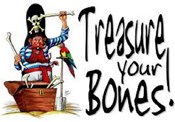October 12- 20 is Bone and Joint Health National Awareness Week.
Osteoporosis is a progressive medical condition in which the bone becomes thinner than normal, and weakens. As a result, bones break easily even with something as simple as a fall. According to the U.S. Surgeon General's Report on Bone Health and Osteoporosis, if Americans don't take action, by the year 2020, half of all persons older than age 50 will be at risk for fractures related to osteoporosis and low-bone mass.
Until a few years ago was considered "old people's" diseases. Today we know differently. Steps to improve bone health start at an early age. Weak bones can affect individuals of all ages.
Whether you are in your 20s, 40s or 70s, it's not too early or too late to make changes in your diet, exercise program and lifestyle to strengthen your bones.
By learning more about osteoporosis, focusing on prevention and taking action, you can alter the course of the disease. Three things that you can do to improve your bone health and make your bones stronger are to take in enough calcium and vitamin D and get enough physical activity every day.
Warning Signs:
A Broken Bone: A broken bone (fracture) as an adult does not always mean you have osteoporosis - but it could be a warning sign that your bones are weak, especially if the break is from normal activities or during a minor fall.
Back Pain or Spinal Deformities: Back pain that will not quit could be a sign that you have a spinal fracture. This occurs when bones in your back become so weak that they fracture and collapse.
Loss of Height: A fractured bone in your spine could collapse onto itself causing you to shrink. Multiple fractures can cause the spine to form a curve causing the disfigurement known as a "dowager's hump."
How Do You Build Strong Bones?
Daily physical activity and a diet high in calcium and vitamin D can help prevent osteoporosis, according to the U.S. Surgeon General's Report.
Building strong bones begins with daily exercise of at least 60 minutes for children and 30 minutes for adults. The best types of exercises for healthy bones are weight-bearing and strength-building activities. Jogging, tennis and walking are types of weight-bearing activities. They are important because they force muscles and bones to work against gravity and they put stress on the limbs. Strength-building exercises - which lead to stronger muscles and bone - include weight-lifting, calisthenics and resistance machines. Exercises, such as Tai Chi, are good because they can help improve your balance, and decrease your risk of falling.
Calcium is a building block of bone and is key to having strong bones. Dairy products and milk are high in calcium; non-dairy foods such as leafy green vegetables, soybeans and salmon also contain calcium but in a lesser amount. If you have problems digesting lactose, which is in dairy products, you may need to take a calcium supplement. Talk with your doctor before starting a supplement.
Individuals need vitamin D to help their bodies absorb calcium from the gastrointestinal tract and to keep bones strong and healthy. The older you become, the more of this vitamin you need. Vitamin D can be synthesized in skin from exposure to the sun or ingested in foods such as fortified dairy products, egg yolks, fish (i.e., salmon, mackerel and tuna), liver, or in supplements.
Risk Factors of Osteoporosis
Gender: Women develop osteoporosis more often than men. Women have less bone tissue to start with and lose bone more rapidly than men as a result of menopause. But men are not immune to this condition, and are often under-diagnosed and inadequately researched.
Age: Bones become less dense and weaker as you age, increasing risk of osteoporosis.
Body Size: Low body weight (under 127 pounds) is an important risk factor for osteoporosis and increased risk of fractures.
Ethnicity: In the United States, Hispanic women are at highest risk - 13 to 16 percent have osteoporosis. Caucasian and Asian women are also at high risk. African-American women have a lower, but significant risk, with 10 percent over age 50 having the disease.
Family History: Individuals whose family members have a history of fractures or osteoporosis seem to have an increased risk for both.
Other Medical Problems: Your chances of osteoporosis increase if you have conditions such as rheumatoid arthritis, Type 1 diabetes, kidney disease, liver disease, inflammatory bowel disease, chronic obstructive pulmonary disease (COPD), anorexia or other eating disorders.
Hormone Levels: Men and women have lower sex hormone levels (such as testosterone and estrogen) as they age. Loss of estrogen, especially after menopause, is the most common cause of osteoporosis in women. Sex hormones in both men and women are necessary to achieve and maintain an adequate amount of bone.
Low Calcium or Vitamin D: People need calcium and vitamin D throughout their lives to build bone.
Inactive Lifestyle: Your bones need weight-bearing exercise, about 30 minutes a day, to remain healthy.
Smoking or Drinking Excessive Amounts of Alcohol: Smoking increases your risk of having osteoporosis as it damages bone cells and prevents new bone growth. More than 2 to 3 ounces a day of alcohol may damage your bones - putting those who consume larger amounts of alcohol at risk.
Source: United States Bone and Joint Initiative, www.usbjd.org







